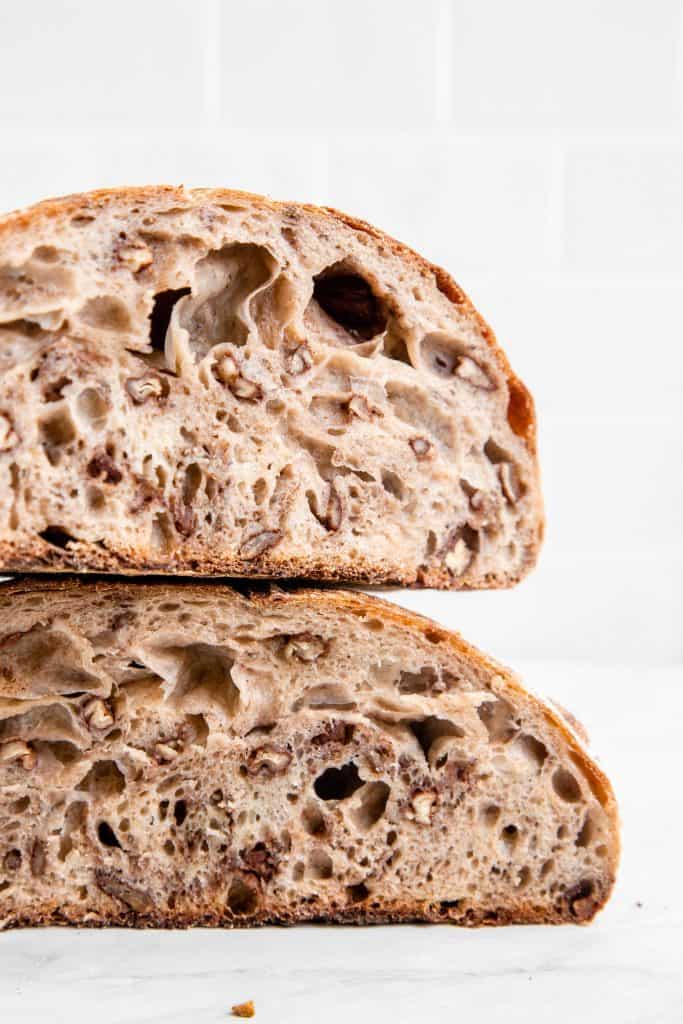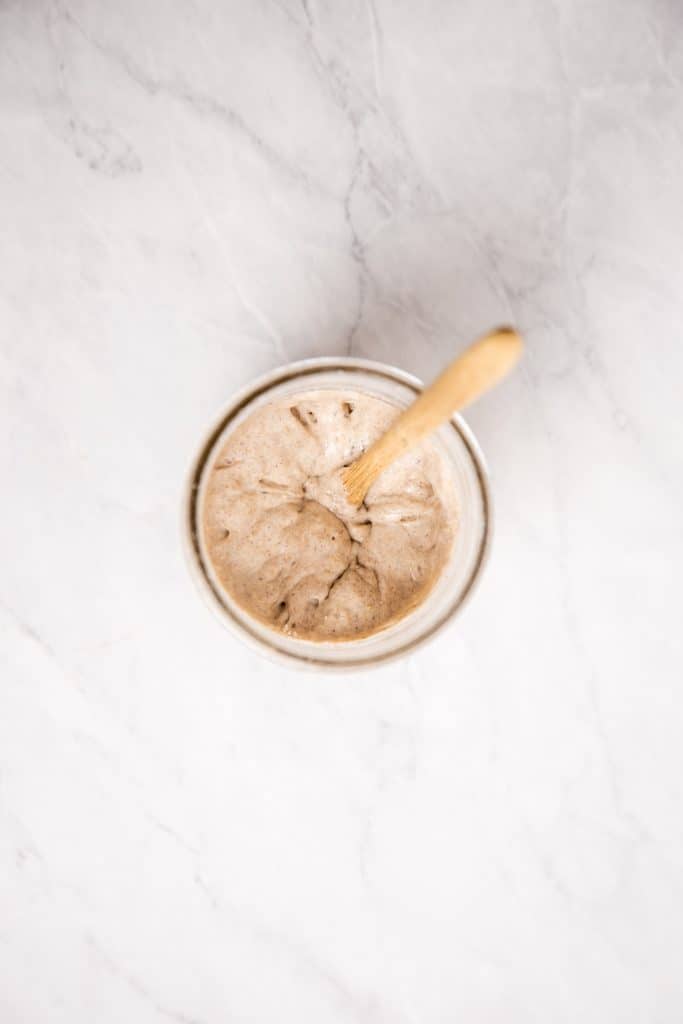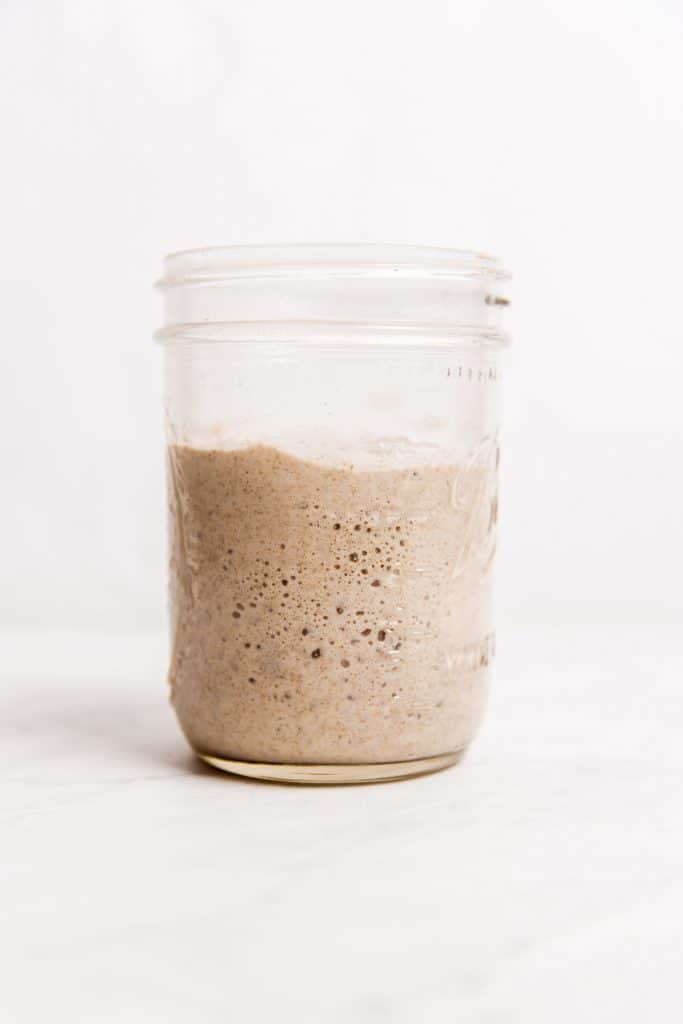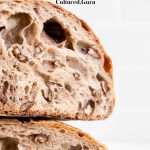How Is Sourdough Fermented?
Sourdough is the oldest form of bread. Experts say that the bread originated in Egypt long ago, as in 5,000 years ago. Since commercial yeasts were obviously not available back then, bread had to be naturally leavened using wild yeast from the grains and wheat.
Wild yeasts are “captured” in a sourdough starter along with flavor developing microorganisms, like acetic acid and lactic acid bacteria. When I say “captured,” I mean they come from the flour you use to make it.
The wild yeasts are significantly more acid-tolerant than packages of baker’s yeast. So the yeasts in sourdough are still very active and able to produce carbon dioxide, even when they’re in the presence of acid-producing bacteria.
The rich flavor comes from the wild yeasts and bacteria metabolizing the sugars in the dough during the long rise times and then producing acids as byproducts. Essentially the microorganisms do some of the digesting for you during all those patient hours you spend kneading and waiting. Aren’t lactic acid bacteria awesome?!

Diversity and Unique Loaves
Multiple factors influence the flavor, rise, texture, and digestibility of sourdough. Using different types of flours in a starter can change and enhance the microbial species richness in the starter. These variations can also change the nutritional components of the bread baked with the starter. The microbes present and the flour you use change the flavor, rise, and sometimes the texture of the bread.
All About Sourdough Starters
When it comes to sourdough, everyone likes to focus on the wild yeasts, but a sourdough starter isn’t all yeast; it’s a mix of yeasts, lactic acid-producing bacteria, and acetic acid-producing bacteria. In wild sourdough starters, yeasts first ferment wheat carbohydrates into alcohol and carbon dioxide. Then, bacteria in the sourdough starter metabolize the alcohols produced by the yeasts into acetaldehyde and then into acetic acid… making it sour.
To read more about what happens microscopically in sourdough starters CLICK HERE and visit our regular sourdough starter recipe blog.

Is Sourdough Really Healthier?
Fermentation in sourdough starters doesn’t happen in succession, it is simultaneous. As soon as the yeast produce any alcohol, the bacteria metabolize whatever alcohol is present into acids. So things do get sour early on. It’s not like the yeasts make all the alcohol first, and then days later, the bacteria decide to start metabolizing it. It’s simultaneous since it is a rich, wild, mixed culture.
Yeasts make bubbles and visible expansion in a starter, but bacteria make all the flavor. Bacteria start making things sour on day one. The bacteria can also metabolize carbohydrates from the flour into acids outright, and then there are wild yeasts that metabolize the lactic acid produced by bacteria for energy. When more good bacteria are present, they can help boot yeast populations by feeding them usable acids and eliminating the waste products (alcohol). The point of discarding and feeding is to refresh the usable substrates available to all the microbes so that the accumulation of waste products does not kill the yeast and bacteria. Sourdough is fascinating because there are so many different types of microbial metabolism and fermentation happening all at once.

Is Sourdough More Nutritious?
Yes! See the image above. Fermentation by yeast and bacteria can alter the levels and bioavailability of phenolic compounds, sterols, vitamins, and minerals. They can also make the fiber more soluble, hence easier to digest! These awesome microbes can even convert lipids, proteins, and starches in the bread to more bioactive forms.
The microogranisms in sourdough starters can also break down fructans in the wheat, making the bread much easier to digest. Fructans are long chains of fructose found in whole grains and wheat, and if not digested properly, fructans can ferment in the colon causing gas, bloating, and diarrhea. A lot of people who have an intolerance to wheat and gluten, actually have an issue with metabolizing fructans in grains. In long fermented sourdough the bacteria breakdown all the fructans with enzymes before you even bake the bread, so the fermentation happens before you eat the bread, instead of in your colon.
What Makes Sourdough Healthier? Less Phytic Acid Means Increased Mineral Bioavailability
Sourdough bread is made out of flour, just like regular bread. However, the fermentation process makes the nutritional components of the flour more bioavailable. In starters, Lactic acid bacteria can reduce phytic acid, the compound that can prevent nutrient absorption in regular bread. Without the phytic acid binding to the minerals, you can absorb more potassium, phosphate, magnesium, folate, and zinc from the bread. Those amazing little lactic acid bacteria also produce antioxidant compounds (postbiotics) and SCFAs (short-chain fatty acids) during fermentation.
Since sourdough ferments during a much longer rise time than conventional bread, the wild microbes can digest and degrade the gluten proteins that normally cause people discomfort and issues. Thanks to mixed microbial fermentation, sourdough bread is much easier to digest and more flavorful.

Sourdough is Overall a Healthier Choice (for you and the planet!)
One thing I love about making my own loaves of sourdough is how little waste it generates! I hate tossing plastic bags in the trash, and when I make my own bread, there’s no plastic waste. Every New Year, Jon and I resolve to lower our waste and footprint somehow. For 2020 we aimed to reduce our plastic consumption as much as possible. COVID has made this difficult at times, but baking all of our own bread has gotten us closer to our plastic-free goals.
I also get to have fun with more flavors, flours, and nutritional ingredients. I love having control over where I source ingredients. This empowers me to provide the most nutritious bread possible to my family. When I make a loaf of sourdough, it’s rarely the same because I like to experiment with different flours. This keeps things fun and exciting. Some flours, like oat and buckwheat, can even enhance the nutritional qualities of the bread.
Summary of What Makes Sourdough Healthier
Traditionally fermented sourdough is healthier than conventional, commercial non-fermented bread, for the following reasons:
- Sourdough contains less gluten than conventional bread. This means sourdough can be a beneficial replacement for anyone who suffers from inflammation, bloating, pain, or indigestion when consuming conventional gluten-containing products.
- Fermentation by yeast and bacteria in sourdough can alter the levels and bioavailability of phenolic compounds, sterols, vitamins, and minerals in bread.
- In starters, Lactic acid bacteria can reduce phytic acid, the compound that can prevent nutrient absorption in regular bread. Without the phytic acid binding to the minerals, you can absorb more potassium, phosphate, magnesium, folate, and zinc from the bread.
- Sourdough bread is an overall healthier choice that can reduce waste.
Sourdough Recipes to Try
- Dutch Oven Sourdough Boule Recipe
- Sourdough Bagels New York Style
- Sourdough Burger Buns
- Buttery Sourdough Garlic Bread Rolls
- How to Bake Sourdough Discard Banana Nut Muffins
*Disclaimer: Sourdough bread may be “easier to digest” but is not recommended for individuals diagnosed with Celiac Disease or serious intolerances to wheat. Consult your doctor if you have food allergies or intolerances.




















Hello, love your site! I know I saw info for converting bread recipes to sourdough here, but can’t find it. Would you direct me to that info, I am going to try to make sourdough Lardy Cakes!